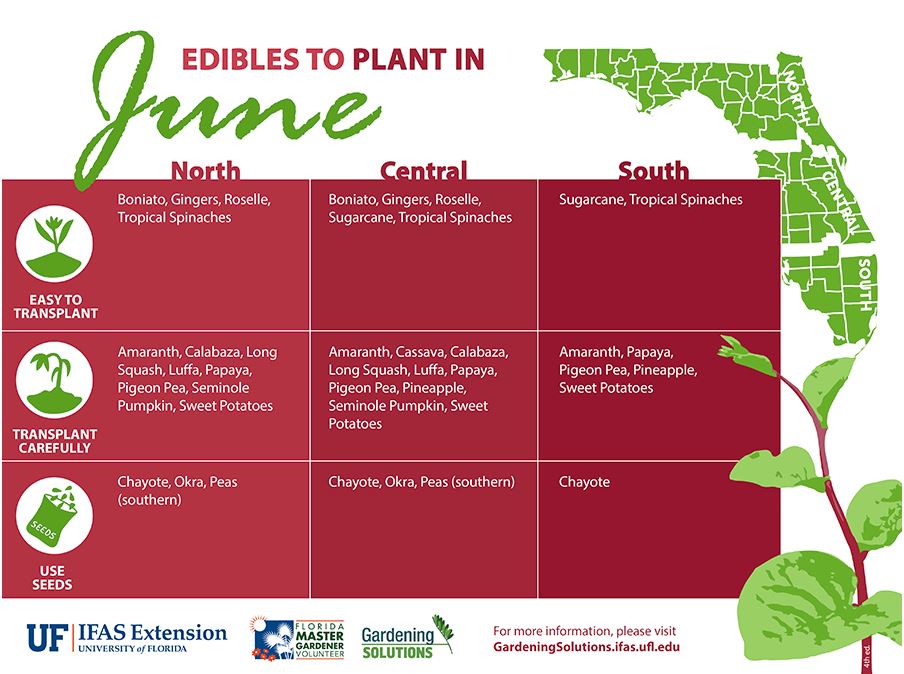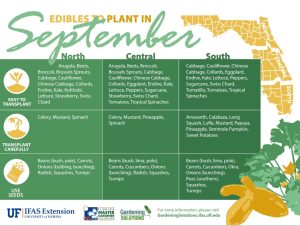Yes, you CAN grow food in Florida year-round. BUT it is important to take a few things into consideration before taking the sweaty plunge into hot season vegetable gardening. Here we aim to share garden tasks and ideas that are seasonally appropriate for Florida in the summer. You can pick and choose what suits your goals and lifestyle. After all, if you don’t like southern summer crops and you overheat easily- a strenuous summer gardening season may spoil your stamina for sowing in early ‘Fall’. If you aren’t sure where you fall on the summer gardening spectrum, and you already have a garden space to grow in, try mixing it up, but on a small scale. This can help you experiment with your space, gain some summer skills, and hopefully have you back into air conditioning before you can say heat stroke…more on that later. This part of the series shares about what you can plant now along with planning and calendar guides.
What crops can I plant in summer?
Some gardeners relish the crops they can grow this time of year, like ginger, okra, sweet potato, and more. Lighting needs and days to harvest can vary. Before planting- evaluate summer crop options, as some may still need space and time in your garden as we move into late summer/early fall planting. Looking at days to harvest for sweet potato and then looking at what you may want to plant in late summer/early fall can help you prioritize your planting plan. For easy references about what edibles to consider planting each month, remember to refer to the edibles to plant infographics by IFAS The same link also shares what flowers to plant, too.
Generally speaking, it isn’t a good time to plant tomato plants. For those that really feel the need, aim for tomatillos, cherry tomatoes or currant-like tomatoes, like Everglades tomato. Or shop for tomato seeds online to sow indoors and transplant in your garden in a couple months. More about that in our next blog.
When asking a friend who is a long-time Florida gardener, community gardener, and master gardener- what he’s been planting lately, the list was long: Sweet Potatoes, Seminole Pumpkin, Watermelons, Peanuts, Sunn Hemp, Puerto Rican Black bean, various Cow Pea (Vigna unguiculata), various walking and bunching onions (trialing this summer), Pineapples, herbs, hot peppers and various edible perennials. For pollinators he added Marigolds, Zinnia, Sunflower, Sesamum indicum, Stachytarpheta jamaicensis, and Salvias (Salvia coccinea).

Infographic of edibles to plant in September
ABC, C is for chayote!
Some longer living edible plants, like chayote, may do well incorporated into your landscape so they aren’t disturbed when you switch out seasonal crops. Chayote can be quite productive and as a perennial, you can gain a lot of food from a small amount of planting. Placing it where it can be undisturbed for a longer time and providing a support for it to vine is ideal. If you haven’t tasted chayote, it would be hard to know if you want to grow your own. Some find it bland; others think it is refreshing. I think its mild flavor and versatility raw or cooked make it a welcome addition to the garden and the kitchen. Explore the many online videos and recipes about how to prepare chayote. I was delighted to eat a chayote salad at a local restaurant recently and it was delicious! To find chayote -I used an online grocery service to find what shops near me may have it in stock- there were at least three nearby. Consider purchasing a couple fruit to try and a spare, so that if you like it- you have a fruit to plant in your yard.
Edible Gardening for your landscape
Some folks use the summer to establish more edibles in their landscaping. Many refer to this as foodscaping, or edible landscaping. Doing this can stretch your growing capacity beyond a vegetable bed to the entirety of your yard. It also helps you expand your options to implement FL Friendly Landscaping by finding the right plant for the right place, and vice versa. For example, pineapple can take over a year to produce fruit, and it doesn’t require a lot of care, so incorporating it in a sunny landscape bed frees up space in your veggie bed for other quicker growing crops that may require better soil or more irrigation. Papaya grows like a tree, and you may not want the height and roots encroaching in your veggie bed so it’s a great addition in other areas of your landscape. Especially areas where you want a bit of vertical height but don’t have a lot of width. Gingers and turmeric prefer to be in some shade so why not use them as an underplanting in your landscape? Some herbs can live for years and low maintenance ones like rosemary don’t need all the TLC a vegetable bed may provide, and by putting them in your landscape they won’t interrupt seasonal changes in your vegetable bed. Explore edible landscaping, or foodscaping, to learn about incorporating fruit trees and perennials- in your yard. Design tips are available for free in this reference, Landscape Design with Edibles and with IFAS resources growing food can still be Florida Friendly, too.
Summer planning for year-round gardening
In Florida, our cold season crops grow gangbusters in the wintertime while veggie gardeners up north wistfully scroll through seed catalogs as they warm themselves by the fire. This is what I imagine happening anyway. In summer during the northern growing months, we explore seed catalogs by the AC vent and outdoor growing is optional. When cooling off indoors, it’s a great time to browse seed catalogs, gardening resources, and to work out your crop plan for the coming year. You can also calendar other gardening tasks using IFAS gardening calendars. That resource provides ideas of what to plant, but also other tips of ‘what to do’ by month. I confess to trying a few of the online ‘garden planners’ that offer click and drag images of vegetable plants to fill a garden map and create a veggie garden plan. Unfortunately, I haven’t found one I find accurate enough when it comes to our growing zone. Please comment on the blog if you garden veg in zone 9b/10 and have found one that is accurate that you have been able to successfully apply in your gardening. For now, I use resources like those linked here along with the Florida Vegetable Gardening Guide to make a rough plan. I prioritize the key crops I want to grow, the times of year best to plant, and working forward and backward to help make the most of my space, year-round. When you pull up that guide be sure to download the PDF or click on ‘show tables’ to see all the helpful charts.
While I enjoy national and regional gardening books and other media for some general vegetable gardening tips, I cross-reference with IFAS to glean UF researched information, from here in FL. When searching online I usually search ‘IFAS’ and the keyword of interest in my search engine. Sometimes I add ‘video’ or ‘blog’ to glean even more variety from UF. For example, the long popular Square Foot Gardening book by Mel Bartholomew, has lots of great information about square foot gardening technique. For us here, we should tweak some of the information regarding timing charts because of our different growing zone here, and sometimes allow greater spacing for some plants like tomatoes. I learn this when searching ‘square foot gardening’ and ‘IFAS’ online, finding short videos like this one from Orange County and a handy blog which also shares about irrigation and even how to build your own garden bed, too. You can also explore all the resources and videos in our Edible Gardening Series cataloged online for your easy reference.
For this blog we focused on options for outdoor planting, and indoor planning. Stay tuned for the next blog where we will share more about edible gardening in FL, summer style. If you are gardening here this summer, feel free to share in the comments what you are currently harvesting, planting, and other timely tasks you are tackling in the summer.
 0
0

